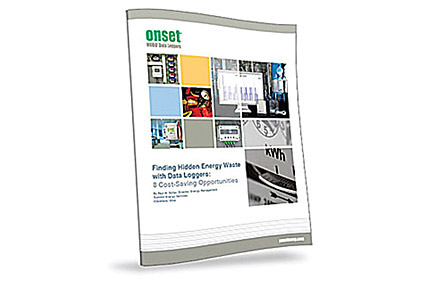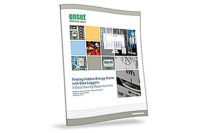Washington State Archives is responsible for preserving millions of records, providing a vital account of the communications, decisions, and actions of governors, legislatures, courts, and state and local agencies in Washington State. Its paper records date back to the establishment of Washington Territory in 1853. Meanwhile, its state Digital Archives facility — the first to be created in the United States — today includes more than 28 million searchable documents, photos, and other records online.
MONITORING FOR HOT SPOTS
For the last seven years, the state’s archives have been stored in a two-floor building co-located on the Eastern Washington State University campus. The facility has systems in place to manage the IAQ and power. Recently, Washington State Archives has added Onset HOBO® ZW Series wireless data nodes for energy and environmental monitoring to help ensure the optimal performance of those systems.
“Temperature and relative humidity monitoring is critical to the preservation of our records,” explains Harold Stoehr, network administrator for Washington State Archives. “For example, down in the paper archives, we have a freezer for storing the old negatives. They could be explosive if they get too warm, so the freezer needs to be monitored around the clock.”
Stoehr notes that temperature monitoring also is important for the data center on the second floor, since the loss of cooling could cause the data systems to crash, or worse, to create a fire. Early detection and notification help provide critical information that staff needs to take corrective action well before a potential fire would set off regular fire alarms.“In general, we had blending of hot and cold with hot spots in some of the aisles,” Stoehr says. “We wanted to track temperature and humidity fluctuations there to gain a better sense for how the HVAC systems were performing.”
WIRELESS MONITORING FACILITATES DATA COLLECTION
Initially, Washington State Archives looked at traditional standalone dataloggers for its environmental monitoring. However, when Stoehr researched the Onset website, he determined that wireless data nodes offered significant benefits.
“Traditional dataloggers would have provided the data we needed, but we didn’t want to spend a lot of time manually retrieving the data throughout the building,” Stoehr recalls. “We figured wireless could really help us a lot, and I was really impressed that we could go with the wireless technology for just a little more money.”
The Washington State Archives facility has nine data nodes on the first floor where the paper records are kept. Eight nodes are used for recording the temperature and relative humidity while a ninth has an external temperature sensor for the freezer. Upstairs, where the data center is housed, there are six data nodes for recording the temperature and relative humidity that include three external voltage sensors and four air velocity sensors.
Information from the data nodes is automatically sent to a receiver, which then stores it on a desktop computer. Accompanying HOBOware® Pro software runs on the computer and provides Stoehr and his team with real-time graphs for each measurement point, as well as alarm notifications.
“The Web service built into the software is really helpful in accessing information,” notes Justin Bouscal, network support specialist for the state archives building in Cheney. “We went ahead and set up an auto log-in account, so that the computer can automatically apply regular critical OS system patches and users can always access the Web server. This lets others in the building look at the data, which is especially useful when someone receives an e-mail ‘alert’ and clicks on the provided URL link.”
ALARM NOTIFICATIONS HELP MITIGATE RISK
Stoehr and his team review the trend logs on HOBOware Pro to see if they need to make any building system adjustments in terms of temperature settings, humidity, and ventilation. They also take advantage of alerts to be notified of potential problems.
For instance, Stoehr says, “We are monitoring the commercial and both of our uninterruptible power supplies, so we can be alerted instantly via cell phone if there are issues. We’re also using airflow sensors connected to the data nodes on the cooling fans, which send us an alert to let us know when they run and log that they came on.”
Stoehr says that the HOBOnode Manager, a component of HOBOware, has been very useful. “We scanned a blueprint of our building and imported it into HOBOnode Manager,” he explains. “Now we can easily see where the nodes are located. It’s really neat.”
WIRELESS DATA NODES REVEAL NEW INSIGHTS
Since setting up the data nodes, Stoehr and his team have gained important insights into the cooling systems aimed at protecting both the paper and digital records.
“We discovered that every eight hours the freezer where our glass negatives are stored rises from 20 to 40 degrees,” Stoehr says. “Apparently the defrost cycle has been working, and this may mean that we end up disabling the auto-defrost cycle and defrost the freezer manually.”
Stoehr adds, “The data helped us realize that we can turn up the setpoint on the cool aisle in the data center and raise the temperature five degrees warmer, which will let us reduce our energy use. This is wonderful information; we’re really excited about it.”
Other information provided by the data nodes has revealed several fluctuations in temperature and relative humidity throughout the facility. Using the trending and reporting information, the team knows when to call HVAC professionals to come work on the equipment.
“We’re also getting a great view of the power coming into our building and a good read on our commercial, emergency generator, and uninterruptible power supplies, which help us ensure they are providing good, consistent power,” Stoehr says. “It’s one more example of how the wireless data nodes are helping us make sure that our archives are getting the best protection possible.” ES


